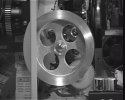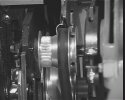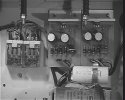FUMEO CLASSIC S8 (PROTOTYPE) TEST REPORT
By Keith Wilton (late March 2002)
To read the complete test report please see the articles in Amateur Cine Enthusiast (ACE Magazine) and Film For The Collector. The following extracts are taken from these magazines.
If you read this and are interested then please contact Phil Sheard at Classic Home Cinema, 51 Cambridge Street, Cleethorpes DN35 8HD
Tel: 44 (0)870 744 6798
http://valueservices.org/classichomecinema/ chcinema@aol.com
The announcement that this projector was forthcoming brought forth a surprising amount of ‘flack’ on both sides of the Atlantic. Even before this prototype arrived it was attacked unseen. While having some personal doubts about the economics of the venture, I, along with my BFCC colleague, John Clancy, an enthusiastic Super 8 collector, and technical co-ordinator at the BFCC, was quite excited about the idea. Also we were willing to keep an open mind about it, offering not only to do the first test report when asked, but also to possibly run it at the 43rd British Film Collectors Convention in May, programme permitting.
| This pre-production model was displayed at the recent Birmingham and Blackpool events but was not seen running. Some of the informed opinions of the static machine being “It looks like a biscuit tin” and “It’s a joke!”. I am happy to report it is neither. Being a prototype there are items that need sorting out. Not all of them require much effort to put right. It is a machine of great potential. Classic’s press release states 150 orders are required to make the enterprise viable. | 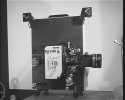 |
RUGGED HEAVYWEIGHT
Of robust construction the machine weighs in at 18 kilograms (the Elmo GS1200 by comparison is a puny 12Kg’s) so it is no lightweight toy. Its origins exist in the Fumeo telecine machine which utilised electronic speed controls and a 600ft reel capacity - more than adequate for film transfers but not necessarily so for the long-term projection of full-length features. This Classic S8 version, with a spool capacity of up to approximately 2,300 bears only an exterior resemblance to the telecine model, otherwise the construction, other than the main frame, sprocket drive gate and soundhead it is entirely different. This is a rugged machine, built to last |  |
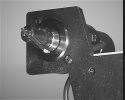 | The telecine casing has been adapted to house the new components and therefore it is at present, a bit rough and ready with several gaps in the case showing allowing quite a bit of light spill. This should be corrected with the new casing which will be crackle black. It is planned to house the take-up and rewind motors within the new casing. Provision should be made for overheating since the take-up motor gets quite hot. Both John Clancy and relative newcomer to the Super 8 hobby, Agnello Guarracino, were of the opinion they liked the motors as they are. In this I concur - in their present form they allow the user, should he wish to experiment, in moving them so they might accommodate even larger reels! |
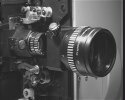 | With the exception of the plastic isolating sound roller and two head-pressers, the film path uses only metal parts - there is no plastic to wear out and scratch precious films. There is no cover over the soundhead area. The gate is well relieved and closes with a satisfying ‘clunk’. Focussing is via a knurled slim-line knob operating at right angles to the lens. The focussing (possibly dependent on the lens fitted) is positive and accurate. The lens barrel is of smooth construction enabling the purchaser to fit virtually any 32.5mm sized lens to the machine which also has one of the best ‘Scope lens mounts that I have come across. |
A QUIET OPERATOR
The Fumeo Classic S8 is quiet in operation and all the mechanical parts are satisfyingly ‘clunky’. The picture appeared nice and bright, reflecting the particular model is fitted with a two-bladed shutter. There is no amplifier fitted, just a pre-amp for feeding the output (switchable to stereo or mono) into a mains amplifier. The most immediate obvious factor was some noticeable hum and a crackling apparent in the background of the film soundtrack. Inside the rear of the projector I located the hum-buckling device and was able to reduce (but not entirely remove) the hum to a much lesser level. The pre-amp is positioned next to and partly under the transformer - in my opinion not the ideal placing for the pre-amp - moving it well away from the transformer may well help to reduce hum.. | 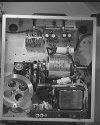 |
STEADY PICTURES
The picture on test was as steady as any 8mm projector I’ve seen - any slight movement observed with the frame line pulled down well into view was due to unsteadiness in printing or the master material. Initially I could not get the picture in focus all over with the Bolex lens supplied by Classic Home Cinema - but like the Elmo GS1200 there is an adjusting screw at the base of the front gate which allows you, with some trial and error I might add, to compensate for lens barrels or optics, for whatever reasons, that do not sit quite in line with the gate.
I tested Derann’s latest ‘Scope offering, Pearl Harbor, on the Fumeo using the ‘Scope holder and bracket. The picture was crisp all over (better than on my GS1200 of late no matter how I fiddle with it). This is due to the excellent, slightly hefty Fumeo gate design, which is well relieved over the picture area and firmly clamps the film flat.
OMISSION
When the electronic Telecine model is run in reverse, the soundhead pressure pads and pinch wheel are lifted, via a lever, presumably operated by a suitable relay (a similar system to that on the Elmo GS1200) , thus putting no undue stress on the claw. In fact in one form or another this is common practice on all Super 8 sound machines. Rather surprisingly on this Classic S8 that facility has been omitted, therefore when attempting to run in reverse the lower loop is lost as the claw attempts to drag the film through the soundhead under full pressure, resulting in film damage. Of course one can manually operate the lever, which is still fitted, but unconnected, and run safely in reverse. This is something that must be rectified at the earliest possible moment. | 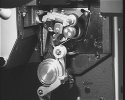 |
Though the machine is manufactured in the former Fumeo Factory in Milan, Italy, there is no connection to Fumeo (UK) Ltd. The machine is only available from Classic Home Cinema. It is priced at £2495 inclusive of VAT but can be supplied without a lens (you may therefore select the lens of your choice) with a saving of about £350. A 115 v USA version is available, VAT free (USA/JAPAN etc) at $3100.
Whilst you might think this a high price for a playback only machine Classic point out that the Beaulieu was £4,800 only last year. And the GS1200 was not considered cheap in its heyday at around £800 in late 70’s and early ‘80’s. With adjustment for inflation it would most certainly cost considerably more than the Fumeo to put into production today.
SUMMARY
Things that must be put right: reduction of hum and the elimination of any crackle. The relief of soundhead pressure during reverse play. The elimination of all light leakage. Correct voltage supply to the lamp.
Recommendations: external adjustment/control of take-up motor. Extend ‘Scope bracket mount slider range. Fit a more substantial mono-stereo switch similar to the mains click-on-off variety. Move the pre-amp.
Footnote. The machine was seen operating during testing by the aforementioned John Clancy with newcomer to the Super 8 hobby, Agnello Guarracino and. Robert Maynard, well versed in projector mechanics and electronics. All three liked the machine and seconded my list of items for rectification. I hope we get to check the first revised production model. |






